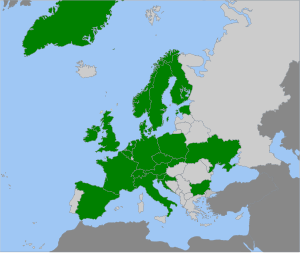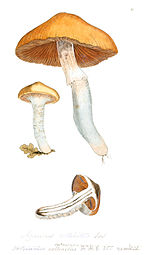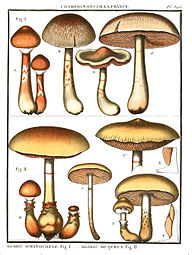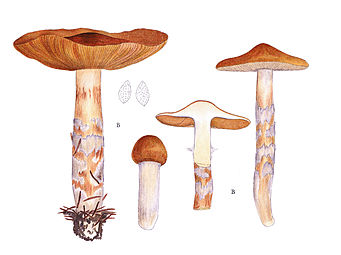Bluestalk slime foot
| Bluestalk slime foot | ||||||||||||
|---|---|---|---|---|---|---|---|---|---|---|---|---|

Bluestalk mucous foot ( Cortinarius collinitus ) |
||||||||||||
| Systematics | ||||||||||||
|
||||||||||||
| Scientific name | ||||||||||||
| Cortinarius collinitus | ||||||||||||
| ( Sowerby ) Gray |
The blue- stalked or violet-stalked mucous foot ( Cortinarius collinitus , syn .: Cortinarius muscigenus ) is a leaf fungus from the family of veil relatives (Cortinariaceae). It has a very slimy, yellow to rust-brown colored hat and an equally slimy, young purple-bluish stem. The meat and the hat skin taste mild. The large almond-shaped spores are at least 10 µm long and ornamented with roughly warty shapes. The mycorrhizal fungus is usually associated with spruce trees. The fruiting bodies appear from July to October mainly in coniferous forests. The mushroom is edible.
features
Macroscopic features
The very slimy hat has a diameter of 3.5-10 cm. It is initially arched, then spread out and often bluntly hunched. The hat is colored yellow or golden brown to dull orange or rust brown. The hump is often darker in color, almost maroon. Young hats can look almost olive brown due to their thick layer of mucus. The edge, which is initially rolled up, is smooth and only corrugated when it is old.
The young pale purple and later more or less rust-brown lamellas are rather crowded. They are bulging on the stem. The edges can sometimes be white. The spore powder is cinnamon to rust brown.
The slender stem is 5–12 (14) cm and 0.7–2 cm wide. It is more or less cylindrical or tapered towards the base. The tip of the stem is whitish or slightly bluish. Due to the slimy coating, the stem appears pale purple. The mucus layer sometimes tears open with age.
The flesh is white when young, then whitish to yellowish-white and tones more or less rust-brown at the base with age. In the tip of the stem it has an occasional bluish tint. The meat tastes mild and is more or less odorless. The smell may also be a bit unpleasantly dull and the taste slightly bitter.
Microscopic features
The finely warty spores are ellipsoidal to almond or almost lemon-shaped. They measure 12–15 (20) × 7–8 (9) µm. The lamellar edges are fertile and without cystidia. The hyphae wear buckles .
Species delimitation
The bluestalk mucous foot is a typical and quite common representative of the subgenus Myxacium . The species in this group are distinguished by their slimy hat and stem. Young fruit bodies are almost completely surrounded by a mucous membrane. This layer can only dry out in very dry weather. Then it leaves a slight snake on the stem. The Schleierling is characterized by its location in a coniferous forest, its stalk, which is more or less bluish-purple in its youth (especially at the tip of the stem), its warm, golden to orange-brown hat color and its extremely large, more or less almond-shaped spores.
He can be confused with several relatives from the same subgenus. The wrinkled, grooved mucous foot ( Cortinarius stillatitius ) has a wrinkled, grooved edge of the hat and looks a bit more compact due to its shorter handle. Throughout the fruiting body lacks the buckle, he is also a characteristic species of acidic and neutral beech forests.
The rare heather mucous foot ( C. mucosus ) can also be similar . It lacks the purple tones on the stem and in the lamellae, while the adder-stalked mucous foot ( C. trivialis ) can be recognized by its strongly padded stem, the darker and duller colored hat and the smaller spores. Other veils with a brown hat and purple lamellas have a dry stem.
Ecology and diffusion
The bluestalk mucous foot is widespread in the entire northern hemisphere and has been detected in North America (USA), Asia (China, Japan, North Korea, South Korea) and Europe. It is common in almost all of Europe. In the south you can find it from Spain to Bulgaria. The mucous foot is also widespread in Great Britain and the Irish island, albeit very rarely. It is very rare in the Netherlands (no evidence since 1987). In the north it occurs throughout Fennoscandinavia . There it is distributed in Sweden and Finland to Lapland and in Norway to the North Cape . It has also been found in Greenland. In the Alpine countries of Liechtenstein, Austria and Switzerland, the blue-stemmed slime foot is common and often found in large numbers. In Germany it is not uncommon, especially in the low mountain ranges.
It prefers montane to subalpine locations in Central Europe . In Switzerland the highest location is at 2110 m above sea level and in Austria the highest locations are above 2100 m. The optimal annual average temperature is 7 ° C, the maximum annual temperature is 9 ° C.
The mycorrhizal fungus grows mainly in the coniferous forest, its most important host tree is the spruce. Sometimes it is also found in pine trees and only rarely in deciduous forests. The fruiting bodies appear from July to October. The fungus prefers to grow in acidic soils. 61% of the records in Austria grew on silicate and only 17% were found on limestone soils.
Systematics
Surprisingly, it is not that easy to give the correct scientific name for the blue-handled slime foot, since the question is still (as of 2015) controversial. The problem begins in 1797, when James Sowerby drew and described a veil that he had found in a park under an oak tree in southwest London and named it Agaricus collinitus. However, it is very unlikely that he drew and described a specimen of this species (in terms of today's species concept). In 1801, CH Persoon took over this name in his work Synopsis methodica fungorum and referred in his description to Pierre Bulliard's plates 549 and 596 Fig. 2, which possibly depict Cortinarius mucosus and Cortinarius trivialis . 1821 also took Elias M. Fries the name and partly Persoons species concept in his Systema Mycologicum , which Sowerby's name sanctioned was. Frie's conception of species, however, corresponds more or less to our present-day conception of Cortinarius trivialis . In 1838 Fries finally placed the taxon in the genus Cortinarius and is therefore given as the first author in many scientific publications. However, he wasn't the first to perform this recombination. As early as 1821, the British botanist Samuel Frederick Gray placed the taxon as Cortinaria collinita (Latin feminine form of the name) in the genus Cortinarius . In 1871 Paul Kummer put the species as Myxacium collinitum in the genus Myxacium , following an effort by many mycologists to split the large and confusing genus Cortinarius into smaller units.
The Danish mycologist JE Lange was one of the few mycologists of his time who dealt more closely with veils. Lange was decided against splitting the genus Cortinarius . He realized that the Frisian species concept of C. collinitus was too broad. In 1940, JE Lange presented a revised species concept. To do this, he separated the species into two species and described a new species, Cortinarius trivalis , which largely corresponds to C. collinitus in the sense of Fries. Lange's conception of species was later also adopted by MM Moser and other authors and corresponds to today's species concept.
In 1888 the American mycologist described Charles Horton Peck with Cortinarius muscigenus a new North American Schleierlingsart. Later studies showed that this taxon is synonymous with the European species C. collinitus in the sense of Lange and MM Moser . Therefore, in order to avoid the ambiguous name C. collinitus , some mycologists suggested using Peck's name for this taxon instead. Another synonym that appears in the literature is Cortinarius cylindripes Kauffm. in the sense of Lange and M. Moser. However, this is an inadmissible use of the name, since the taxon described by CH Kauffman is an independent North American species.
meaning
The blue stalk mucous foot is edible and one of the good tasting veils.
swell
- Cortinarius collinitus. In: Index Fungorum. Retrieved October 5, 2015 .
- Cortinarius collinitus. In: MycoBank.org. International Mycological Association, accessed October 5, 2015 .
- PD Orton: Cortinarius I: Myxacium and Phlegmacium . In: The Naturalist . tape 7 , no. 6 , 1955, pp. 1-80 ( britmycolsoc.org.uk [PDF]).
Individual evidence
- ↑ a b c Marcel Bon : Parey's book of mushrooms . Kosmos, Stuttgart 2005, ISBN 3-440-09970-9 , pp. 202 (English: The mushrooms and tools of Britain and Northwestern Europe . Translated by Till R. Lohmeyer).
- ↑ a b c Ewald Gerhardt: Mushrooms. Volume 1: Lamellar mushrooms, pigeons, milklings and other groups with lamellas (= spectrum of nature / BLV intensive guide ). BLV, Munich / Vienna / Zurich 1984, ISBN 3-405-12927-3 , p. 252 .
- ↑ a b Karin Monday: Blue-stalked slime foot Cortinarius collinitus In the virtual mushroom book. In: Tintling.com. Retrieved October 5, 2015 .
- ↑ Rapportsystemet för växter: Cortinarius collinitus. (No longer available online.) In: artportalen.se. Archived from the original on December 24, 2009 ; accessed on December 14, 2015 . Info: The archive link was inserted automatically and has not yet been checked. Please check the original and archive link according to the instructions and then remove this notice.
- ^ Cortinarius collinitus. In: basidiochecklist.info. Retrieved December 14, 2015 .
- ↑ Cvetomir M. Denchev & Boris Assyov: Checklist of the larger basidiomycetes in Bulgaria . In: Mycotaxon . tape 111 , 2010, ISSN 0093-4666 , p. 279–282 ( Online [PDF; 592 kB ; accessed on June 5, 2019]).
- ^ Belgian List 2012 - Cortinarius collinitus. Retrieved December 14, 2015 .
- ↑ a b Torbjørn Borgen, Steen A. Elborne and Henning Knudsen: Arctic and Alpine Mycology . Ed .: David Boertmann, Henning Knudsen. tape 6 . Museum Tusculanum Press, 2006, ISBN 978-87-635-1277-0 , A checklist of the Greenland basidiomycetes, p. 37-59 ( books.google.de ).
- ↑ Armin Mesic & Zdenko Tkalcec: Preliminary checklist of Agaricales from Croatia. II. Families Agaricaceae, Amanitaceae, Cortinariaceae and Hygrophoraceae. In: Mycotaxon . tape 83 , 2002, pp. 453–502 ( online [accessed June 5, 2019]).
- ^ Estonian eBiodiversity Species description Cortinarius collinitus. elurikkus.ut.ee, accessed on December 14, 2015 (English).
- ↑ Ilkka Kytövuori et al .: 4.1 Helttasienten ja tattien levinneisyystaulukon selitykset . In: Suomen helttasienten ja tattien ekologia, levinneisyys ja uhanalaisuus . 2005, ISBN 952-11-1997-7 , pp. 105–225 (Finnish, online [PDF; 7.4 MB ; accessed on June 5, 2019]).
- ↑ a b Worldwide distribution of Cortinarius collinitus. (No longer available online.) In: GBIF Portal / data.gbif.org. Archived from the original on December 22, 2015 ; accessed on December 14, 2015 . Info: The archive link was inserted automatically and has not yet been checked. Please check the original and archive link according to the instructions and then remove this notice.
- ↑ a b Jean-Pierre Prongué, Rudolf Wiederin, Brigitte Wolf: The mushrooms of the Principality of Liechtenstein . In: Natural history research in the Principality of Liechtenstein . Vol. 21. Vaduz 2004 ( online [PDF; accessed on December 16, 2015]). Online ( Memento of the original from November 15, 2011 in the Internet Archive ) Info: The archive link was inserted automatically and has not yet been checked. Please check the original and archive link according to the instructions and then remove this notice.
- ↑ Nahuby.sk - Atlas hub - Cortinarius collinitus. (No longer available online.) In: nahuby.sk. Formerly in the original ; accessed on December 14, 2015 . ( Page no longer available , search in web archives ) Info: The link was automatically marked as defective. Please check the link according to the instructions and then remove this notice.
- ↑ Grid map of Cortinarius collinitus. In: NBN Gateway / data.nbn.org.uk. Retrieved December 14, 2015 .
- ^ Cortinarius collinitus. Pilzoek database, accessed December 14, 2015 .
- ^ TV Andrianova et al .: Cortinarius collinitus. Fungi of Ukraine. (No longer available online.) In: cybertruffle.org.uk. Archived from the original on December 22, 2015 ; accessed on December 14, 2015 . Info: The archive link was inserted automatically and has not yet been checked. Please check the original and archive link according to the instructions and then remove this notice.
- ↑ a b NMV Verspreidingsatlas online: Cortinarius collinitus. In: verspreidingsatlas.nl. Retrieved December 14, 2015 .
- ↑ a b Database of mushrooms in Austria. In: austria.mykodata.net. Austrian Mycological Society, accessed December 14, 2015 .
- ↑ Distribution atlas of mushrooms in Switzerland. (No longer available online.) In: wsl.ch. Federal Research Institute for Forests, Snow and Landscape WSL, archived from the original on October 15, 2012 ; accessed on December 14, 2015 . Info: The archive link was inserted automatically and has not yet been checked. Please check the original and archive link according to the instructions and then remove this notice.
- ↑ James Sowerby: Colored figures of English fungi or mushrooms . Printed by J. Davis, London 1797, pp. 4 , plate 9 ( biodiversitylibrary.org ).
- ↑ Christiaan Henrik Persoon: Synopsis methodica fungorum Pars secunda . Sistens envmerationem omnivm hvc vsque detectarvm speciervm, cvm brevibvs descriptionibvs nec non synonymis et observationibvs selectis. Ed .: Gottingae: Apvd Henricvm Dieterich. 1801, p. 281 (Latin, bibdigital ).
- ↑ Elias Magnus Fries: Agaricus . In: Systema Mycologicum . tape I . Ex Officina Berlingiana., Lund & Greifswald 1821, p. 248 (Latin, online [accessed June 5, 2019]).
- ^ Elias Magnus Fries: Agaricini . In: Epicrisis systematis mycologici - seu synopsis hymenomycetum . Typographia Academica, Upsala 1838, p. 274 (Latin, online [accessed June 5, 2019]).
- ^ Samuel Frederick Gray : A natural arrangement of British plants . according to their relations to each other as pointed out by Jussieu, De Candolle, Brown. Ed .: F. Bataille, Besançon. Vol 1. London 1821, pp. 628 ( Biodiversity Heritage Library ).
- ↑ Paul Kummer: The guide to mushroom science . Instructions for the methodical, easy and safe determination of the fungi occurring in Germany. 2nd Edition. G. Luppe, Hof-Buchhandlung, Zerbst 1871, p. 93 ( biodiversitylibrary.org ).
- ↑ Jakob Emanuel Lange: C. Trivialis . In: Flora agaricina Danica. tape 3 : V. Recato, Copenhagen 1940, p. 24 (English, online [accessed June 5, 2019]).
- ^ Charles Horton Peck: Annual report of the Trustees of the State Museum of Natural History . In: Report of the Botanist . tape 41 . New York 1887, p. 71 ( Biodiversity Heritage Library ).
- ↑ Cortinarius subgenus Myxacium . In: Field Mycology . tape 10 , no. 2 , 2009, p. 41–55 ( britmycolsoc.org.uk [PDF; accessed December 16, 2015]). britmycolsoc.org.uk ( Memento of the original from December 22, 2015 in the Internet Archive ) Info: The archive link has been inserted automatically and has not yet been checked. Please check the original and archive link according to the instructions and then remove this notice.
- ^ Calvin Henry Kauffman: Bulletin of the Torrey Botanical Club. tape 32 , no. 6 , 1905, pp. 321 ( biodiversitylibrary.org ).
Web links
- Cortinarius collinitus. In: Funghi in Italia / funghiitaliani.it. Retrieved October 5, 2015 (Italian, photos dated n).
- M. Kuo: Cortinarius collinitus. In: MushroomExpert.Com. Retrieved October 5, 2015 .
- Wolfgang Bachmeier: Bluestalk slime foot (Cortinarius collinitus). In: www.123pilze.de / pilzseite.de. Retrieved October 5, 2015 .
- Roger Phillips: Cortinarius collinitus. In: RogersMushrooms. Rogers Plants Ltd., accessed December 15, 2015 .




